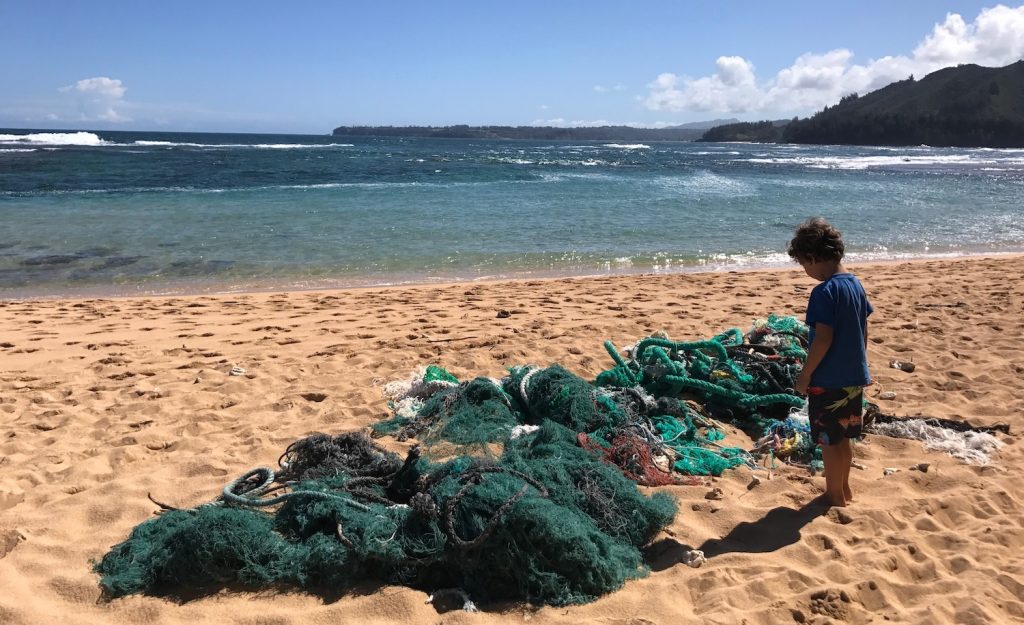
05.30.24
Using Beach Cleanup Data to Identify Shifts in Plastic Pollution Abundance
By Lauren BlickleyFor over a decade, Surfrider Foundation Kaua'i Chapter has been removing thousands of pounds of ocean-based debris from the island's shorelines. Ocean-based debris, as compared to land-based debris, originates from sources outside of our islands. For example, fishing gear from large-scale commercial fishing vessels, aquaculture debris, debris lost from offshore oil and gas work, trash dumped off of cruise ships, and containers that fall off of large shipping vessels that transport products across the ocean. Land-based debris, on the other hand, includes rubbish from local sources like beachgoers who leave their trash behind or debris that is littered on the land and makes its way to the beach.
To address the large influx of debris littering the Kaua'i shoreline, Surfrider Kaua'i volunteers launched the Net Patrol Program in 2012. In the last decade, not only have Net Patrol volunteers removed thousands of pounds debris off of Kaua'i coastlines, they have also collected valuable data about the movement of plastic pollution in the North Pacific.
In 2024, Surfrider Foundation Kaua'i, Hawai'i Wildlife Fund, and researchers from University of Hawai'i at Manoa published the results from their combined data in Marine Pollution Bulletin, in an study titled "Interannual variability in marine debris accumulation on Hawaiian shores: The role of North Pacific Ocean basin-scale dynamics."
The study evaluated marine debris removal data from 2013-2022 on the islands of Kaua'i and Hawai'i. Most of this debris was from abandoned, lost, and derelict fishing gear. The study hypothesized that the amount of marine debris arriving on Hawai'i shorelines is determined by the proximity of the North Pacific "garbage patch" to the Hawaiian islands. The North Pacific garbage patch, in turn, is influenced by large-scale ocean dynamics that can shift the North Pacific current either north or south. The amount of marine debris collected along Kaua'i and Hawai'i coastlines was compared with an oceanographic drift model. The study determined that annual variations in debris accumulation corresponded to the movement of the North Pacific garbage patch (either closer or further away from Hawai'i).
In recent years, beach cleanup efforts on Kaua'i and Hawai'i Island have collected less debris on the beach. According to the study's findings, however, the recent decline in the amount of debris collected is due to the movement of the North Pacific garbage patch away from Hawai'i - not because there is a reduction in the amount of debris polluting the ocean. The oceanographic drift model utilized in the study further predicts that in 2024, the North Pacific garbage patch will once again move closer to the Hawaiian Islands and, in turn, result in an increased amount of debris along Hawai'i beaches. The reality of these predictions are already being realized, with Surfrider Foundation Kaua'i Chapter volunteers removing an increased amount of debris during their Net Patrol cleanups in the first part of 2024. Climate change and its impacts on ocean surface temperatures, ocean currents, and more are further expected to impact the movement of debris throughout our ocean.
Special thanks to Surfrider Kaua'i Volunteers Dr. Carl Berg and Cynthia Welti who led the data reporting and drafting of the paper, as well as Barbara Wiedner and Scott McCubbins who have tirelessly led the Net Patrol Program for many years.
